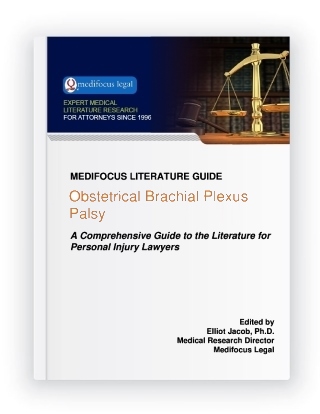Obstetrical Brachial Plexus PalsyA Comprehensive Guide to the Literature for Personal Injury Lawyers
Publisher: Medifocus Legal
Publication Date: June 5, 2020
Number of Pages: 132
A Comprehensive Guide to the Literature for Personal Injury Lawyers
Publisher: Medifocus LegalPublication Date: June 5, 2020
Number of Pages: 132
The literature describes a variety risk factors for OBPP, however, according to the American College of Obstetricians and Gynecologists (ACOG), with the exception of shoulder dystocia, these risk factors have not been shown to be statistically significant or clinically useful predictors for the occurrence of OBPP.
The clinical presentation of OBPP can vary depending upon the origin of the injury:
- Upper-trunk OBPP injuries (Erb's palsy) involve the C5-C6 nerve roots and are characterized by lack of active shoulder abduction and elbow flexion, while hand function is preserved.
- Lower-trunk OBPP injuries (Klumpke's palsy) involve the C8 and T1 nerve roots and are characterized by complete hand and wrist involvement.
- Injury to the total brachial plexus involves C5-C8 and occasionally the T1 nerve roots and affect the shoulder, elbow, hand and wrist. Horner's sign is usually present with symptoms including decreased pupil size, a drooping eyelid, and reduced sweating on the affected side of the face.
Families of infants and children who incur a brachial plexus birth injury often turn to a personal injury lawyer to help them seek compensation for an injury that they believe was preventable and was caused through the negligence of the attending OB/GYN. In fact, studies have reported that OBPP is one of the most common reasons for obstetric litigation. One recent study found that nearly 50% of families with infants and children who sustained OBPP filed a malpractice lawsuit.
The MediFocus Literature Guide to Obstetrical Brachial Plexus Palsy captures the salient articles published over the past two decades in peer-reviewed medical journals and focuses on the risk factors, management, and prognosis for infants and children who sustained a brachial plexus birth injury. This unique Literature Guide consists of over 180 hand-selected articles published in peer-reviewed journal with links to the Abstracts of each article. The Guide also includes a valuable Author Directory for quickly identifying and locating medical experts for case evaluation and expert testimony.
 |
- A comprehensive bibliography of 184 journal article references indexed in MEDLINE published in well respected medical and scientific journals.
- Online access to the abstracts (summaries) of the articles.
- Online access to the free full-text version of 19 articles.
- Links to full-text sources of other articles that are available for purchase directly from individual journal publishers.
- A unique "Author Directory" consisting of the names and institutional affiliations of experts who have published and have specialized knowledge about Obstetrical Brachial Plexus Palsy. The "Author Directory" is a valuable resource for quickly identifying and locating experts for case reviews, opinions, and testimony.
Select examples of topics that are covered by the articles referenced in this Guidebook include:
- The Association of Clavicle Fracture With Brachial Plexus Birth Palsy.
- Outcomes from primary surgical reconstruction of neonatal brachial plexus palsy in 104 children.
- Obstetric brachial plexus palsy - A prospective, population-based study of incidence, recovery and long-term residual impairment at 10 to 12 years of age.
- Reliability and validity of the Brachial Plexus Outcome Measure in children with obstetric brachial plexus palsy.
- The Epidemiology of Brachial Plexus Birth Palsy in the United States: Declining Incidence and Evolving Risk Factors.
- Obstetric brachial plexus injuries: health-related quality of life in affected adults and parents.
- Participation restrictions among adolescents and adults with neonatal brachial plexus palsy: the patient perspective.
- Obstetric brachial plexus palsy: a population-based retrospective case-control study and medicolegal considerations.
- Long-term Follow-up of Neonatal Brachial Plexopathy: Psychological and Physical Function in Adolescents and Young Adults.
- Sensory outcomes following brachial plexus birth palsy: A systematic review.
- Neonatal brachial plexus palsy: obstetric factors associated with litigation.
- Risk factors for persistent disability in children with obstetric brachial plexus palsy.
- Peripartum and neonatal factors associated with the persistence of neonatal brachial plexus palsy at 1 year: a review of 382 cases.
- Outcome in adolescence of brachial plexus birth palsy. 69 individuals re-examined after 10 and 20 years.
- Executive summary: Neonatal brachial plexus palsy. Report of the American College of Obstetricians and Gynecologists' Task Force on Neonatal Brachial Plexus Palsy.
- Obstetric brachial plexus palsy following routine versus difficult deliveries.
- Health-related quality of life in children with obstetrical brachial plexus palsy.
- Quality of life in mothers of children with obstetrical brachial plexus palsy.
- Burnout, depression and anxiety levels in mothers of infants with brachial plexus injury and the effects of recovery on mothers' mental health.
- Causes of neonatal brachial plexus palsy.
is available in two formats: | |
Order by Phone:To order by phone, please call: Order by Mail:To order by mail, please print and complete this Order Form | |

